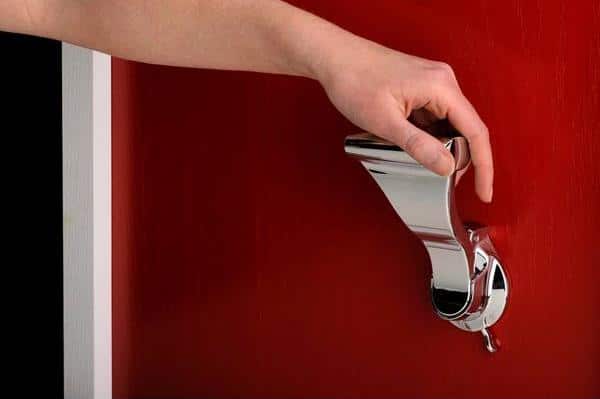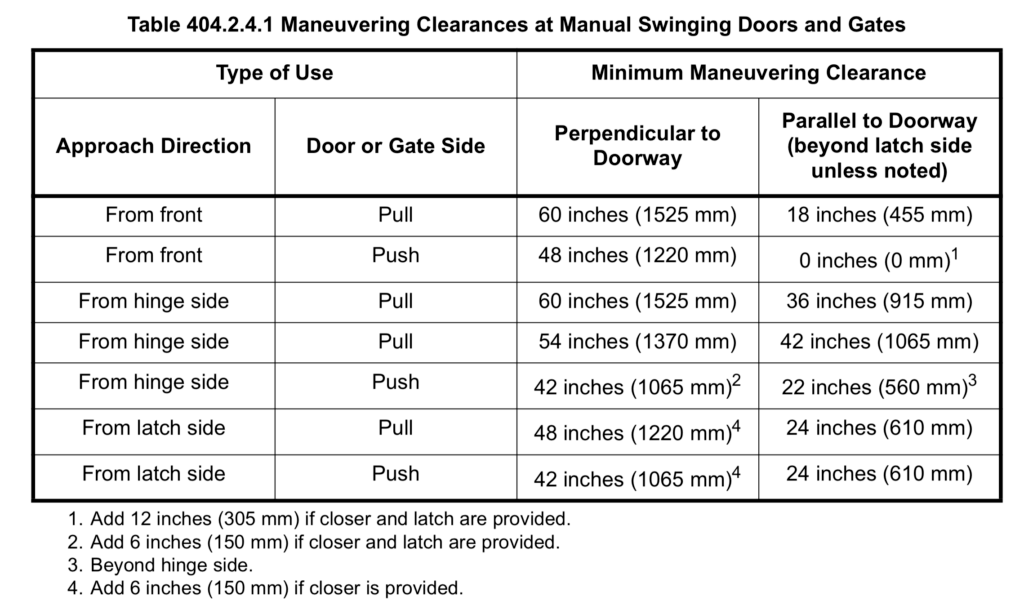I Left the Door Open to the Pain Dimension Again

The Americans with Disabilities Act (ADA) is an American Police which was enacted in 1990. The legislation actually deals with the ceremonious rights of individuals with disabilities. The law has imposed several guidelines and requirements on a number of different areas including:
- Employment
- Government Programs
- Public Accommodation
- Telecommunication
Architects, designers and contractors are required to bide by all sections of the ADA — the near pertinent requirements being those in the public adaptation sector.
1 of the most commonly searched questions regarding this law surrounds the ADA door requirements. This article will cover all of those requirements in detail, including:
- Dissimilar Door Types (Entrance, Interior, Gates, etc.)
- Maneuvering Clearance Requirements
- ADA Door Handle Requirements (Meridian of Hardware, etc.)
- Door Opening and Endmost Requirements
Note: All of the requirements discussed can be found in the lengthy section 404 of the Americans with Disabilities Act.
Unlike Door Types Covered Under the ADA
Size requirements laid out in the Americans with Disabilities legislation are beneficially clear and utilise to nearly every door and opening in whatever accommodation. That said, the hardware and direction (handles, latches and which way the door opens) can get a chip confusing.
In general, the requirements are a minimum of 32" in width and a maximum of 48" and the door must open up to xc degrees.
Department 404 of the ADA states:
"Door openings shall provide a articulate width of 32 inches (815 mm) minimum. Clear openings of doorways with swinging doors shall be measured between the face of the door and the stop, with the door open ninety degrees."
The Clear Width
The width requirements are known as the "clear width" clear width is substantially how wide a immigration/opening is required, measured from between the face up of the door and the terminate.
Here is a helpful image from the ADA itself:

It is helpful to think near all types of doors and entrances when designing or during construction. Here is a cursory list.
- Manual Outside Doors
- Manual Interior Doors
- Manual Specialty Doors (showers, tubs, closets, etc.)
- Manual Gates
- Transmission Double Doors
- Openings without Doors
Annotation: The ADA does mention turnstiles and revolving doors. These are not nether ADA guidelines, simply must not be the just fashion to pass through in whatsoever adaptation.
Articulate Width and ADA Maneuvering Clearances
Once you lot empathise the ADA door width requirements, it's time to discuss the maneuvering clearances. When considering the challenges of certain equipment used by individuals with disabilities — information technology'due south easy to sympathize the need for universal clearances.
While this section of the ADA has quite a fleck more information, it is still clearly laid out. Here are the maneuvering clearance requirements from the legislation:

(Source)
Hither are a few examples to assistance understand the language used in the to a higher place diagram:
Example Ane: If yous approach a gate from the front and push the gate to open it, there needs to be a minimum of 48 inches of clearance on the side an individual would be opening the door. (The clearance would be where a person is continuing or sitting — about to open the door.
Example Two: If you approach a door from the latch side and volition need to pull the door open, the minimum clearance on the opening side, perpendicular to the doorway, is 48 inches to let for the door to open up, leaving room for a disabled individual to motion. On the parallel side, beyond the latch, is 24 inches (should the door need to swing open wide).
ADA Door Handle Requirements
Clearance and maneuvering width is vital to the structural layout of a building, only the ADA doesn't terminate there. In addition to the components we've covered, at that place are also extensive ADA door handle requirements laid out in the legislation.
These rules are in department 404.ii.7 of the ADA itself. Handle and other hardware also falls under the "operable parts" (department 309.4).
Section 309.4 says, "Operable parts shall be operable with one hand and shall not crave tight grasping, pinching, or twisting of the wrist. The strength required to actuate operable parts shall be 5 pounds (22.2 Northward) maximum."
The maximum force required is five pounds, but less than this would be platonic for those who either tin can't grip well or are in a position prohibiting practiced leverage to open a door. In fact, at that place is a special section of the ADA for extra guidelines. These aren't part of the law, but fall nether and "advisory".
Here it is from the ADA, "Door hardware that can exist operated with a closed fist or a loose grip accommodates the greatest range of users. Hardware that requires simultaneous hand and finger movements require greater dexterity and coordination, and is non recommended."
This advice should ring true to virtually, especially for those designing structures and accommodations for the disabled and elderly. Structures who may desire to heed to this informational almost would be:
- Hospitals and medical facilities
- Assisted living facilities
- Nursing homes
- Retirement communities
Notation: The Ultralatch is designed to require less strength than traditionally ADA approved handles. Here'south a quick look at how information technology works in the video below:
ADA Door Handle Height Requirement
The height of the door handle must be between a minimum of 34" and a maximum of 48". A few exceptions are included in the bill. Things like:
- Pre-existing locks (most likely not applicable to new builds)
- Gates protecting pools, spas and hot tubs are allowed to be a bit higher (upwards to 54")
Door Opening and Closing Requirements
Door and Gate Opening Force
In improver to section 309.4, another section speaks of the corporeality of strength when opening doors and gates. Department 404.2.ix covers two types of doors. The ADA says,
"1. Interior hinged doors and gates: 5 pounds (22.two Due north) maximum.
- Sliding or folding doors: 5 pounds (22.two N) maximum."
There is also another informational in this section of the pecker:
"The maximum force pertains to the continuous awarding of force necessary to fully open up a door, not the initial force needed to overcome the inertia of the door. It does not utilize to the force required to retract bolts or to undo other devices used to keep the door in a closed position."
Door Closing Speed
Again, the door endmost speed is separated into two categories:
- Door and Gate Closers in General
- Spring Hinges
All of the closers are required to go from 90 degrees opened to 12 degrees opened in no less than v seconds. Leap hinges are required to go from 70 degrees to completed closed in no less than 1.v seconds.
Conclusion
Creating a structure that abides by the constabulary is important. However, the law serves a more than important purpose — to let for those with disabilities to successfully perform common functions. Providing those who take disabilities with doors, handles and other hardware which will assist them enter and pass through buildings is the right thing to do.
P.S.
You tin can now buy the UltraLatch directly from SOSS at Factory Directly Pricing. Shop Hither
Source: https://www.soss.com/guide-to-ada-door-requirements-width-clearance-and-handle-guidelines/
0 Response to "I Left the Door Open to the Pain Dimension Again"
Post a Comment